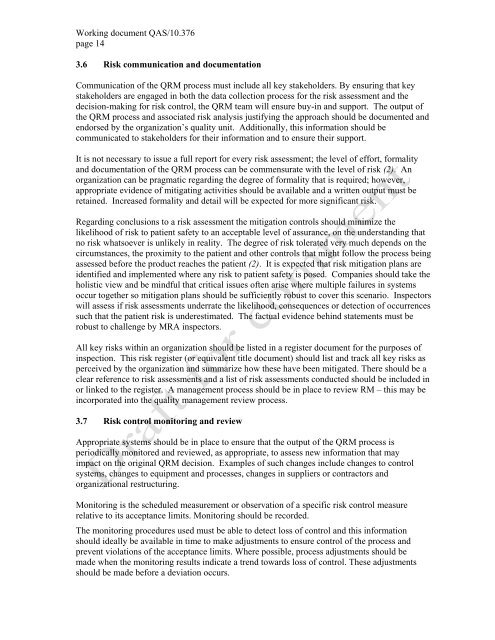who guideline on quality risk management - World Health ...
who guideline on quality risk management - World Health ...
who guideline on quality risk management - World Health ...
Create successful ePaper yourself
Turn your PDF publications into a flip-book with our unique Google optimized e-Paper software.
Working document QAS/10.376<br />
page 14<br />
3.6 Risk communicati<strong>on</strong> and documentati<strong>on</strong><br />
Communicati<strong>on</strong> of the QRM process must include all key stakeholders. By ensuring that key<br />
stakeholders are engaged in both the data collecti<strong>on</strong> process for the <strong>risk</strong> assessment and the<br />
decisi<strong>on</strong>-making for <strong>risk</strong> c<strong>on</strong>trol, the QRM team will ensure buy-in and support. The output of<br />
the QRM process and associated <strong>risk</strong> analysis justifying the approach should be documented and<br />
endorsed by the organizati<strong>on</strong>’s <strong>quality</strong> unit. Additi<strong>on</strong>ally, this informati<strong>on</strong> should be<br />
communicated to stakeholders for their informati<strong>on</strong> and to ensure their support.<br />
It is not necessary to issue a full report for every <strong>risk</strong> assessment; the level of effort, formality<br />
and documentati<strong>on</strong> of the QRM process can be commensurate with the level of <strong>risk</strong> (2). An<br />
organizati<strong>on</strong> can be pragmatic regarding the degree of formality that is required; however,<br />
appropriate evidence of mitigating activities should be available and a written output must be<br />
retained. Increased formality and detail will be expected for more significant <strong>risk</strong>.<br />
Regarding c<strong>on</strong>clusi<strong>on</strong>s to a <strong>risk</strong> assessment the mitigati<strong>on</strong> c<strong>on</strong>trols should minimize the<br />
likelihood of <strong>risk</strong> to patient safety to an acceptable level of assurance, <strong>on</strong> the understanding that<br />
no <strong>risk</strong> whatsoever is unlikely in reality. The degree of <strong>risk</strong> tolerated very much depends <strong>on</strong> the<br />
circumstances, the proximity to the patient and other c<strong>on</strong>trols that might follow the process being<br />
assessed before the product reaches the patient (2). It is expected that <strong>risk</strong> mitigati<strong>on</strong> plans are<br />
identified and implemented where any <strong>risk</strong> to patient safety is posed. Companies should take the<br />
holistic view and be mindful that critical issues often arise where multiple failures in systems<br />
occur together so mitigati<strong>on</strong> plans should be sufficiently robust to cover this scenario. Inspectors<br />
will assess if <strong>risk</strong> assessments underrate the likelihood, c<strong>on</strong>sequences or detecti<strong>on</strong> of occurrences<br />
such that the patient <strong>risk</strong> is underestimated. The factual evidence behind statements must be<br />
robust to challenge by MRA inspectors.<br />
All key <strong>risk</strong>s within an organizati<strong>on</strong> should be listed in a register document for the purposes of<br />
inspecti<strong>on</strong>. This <strong>risk</strong> register (or equivalent title document) should list and track all key <strong>risk</strong>s as<br />
perceived by the organizati<strong>on</strong> and summarize how these have been mitigated. There should be a<br />
clear reference to <strong>risk</strong> assessments and a list of <strong>risk</strong> assessments c<strong>on</strong>ducted should be included in<br />
or linked to the register. A <strong>management</strong> process should be in place to review RM – this may be<br />
incorporated into the <strong>quality</strong> <strong>management</strong> review process.<br />
3.7 Risk c<strong>on</strong>trol m<strong>on</strong>itoring and review<br />
Appropriate systems should be in place to ensure that the output of the QRM process is<br />
periodically m<strong>on</strong>itored and reviewed, as appropriate, to assess new informati<strong>on</strong> that may<br />
impact <strong>on</strong> the original QRM decisi<strong>on</strong>. Examples of such changes include changes to c<strong>on</strong>trol<br />
systems, changes to equipment and processes, changes in suppliers or c<strong>on</strong>tractors and<br />
organizati<strong>on</strong>al restructuring.<br />
M<strong>on</strong>itoring is the scheduled measurement or observati<strong>on</strong> of a specific <strong>risk</strong> c<strong>on</strong>trol measure<br />
relative to its acceptance limits. M<strong>on</strong>itoring should be recorded.<br />
The m<strong>on</strong>itoring procedures used must be able to detect loss of c<strong>on</strong>trol and this informati<strong>on</strong><br />
should ideally be available in time to make adjustments to ensure c<strong>on</strong>trol of the process and<br />
prevent violati<strong>on</strong>s of the acceptance limits. Where possible, process adjustments should be<br />
made when the m<strong>on</strong>itoring results indicate a trend towards loss of c<strong>on</strong>trol. These adjustments<br />
should be made before a deviati<strong>on</strong> occurs.

















